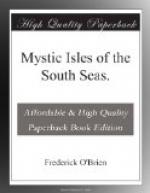There were trees, bushes, and plants of yellow and white coral, of scarlet corallins, dahlias and roses, cabbages and cauliflowers simulated perfectly, lilies and heaps of precious stones. On flat tables were starfish lazying at full width, strewn shells, and hermit-crabs entering and leaving their captured homes. Mauve and primrose, pink and blue, green and brown, the coral plants nodded in the glittering light that filtered through the translucent brine. They were alive, all these things, as were the sponges, with stomachs and reactions, and impulses to perpetuate their species and to be beautiful. They had no relation to me except as I had to nature, but they were my beginnings, my simple ancestors who had stayed simple and unminded, and I was to count those hours happy when I communed with them.
Taken from their element they died, but left their mold, to harden in the air they could not breathe, and to amaze the less fortunate people who could not see them in their own estate. The seaweeds grew among them, green or brown, more primordial than the corals, with less of organic life, vegetables and not animals, but eager, too, for expression in their motions, their increase in size, and their continuance through posterity. All these were the display of the kindness of the same spirit who rode the thunder, who permitted a million babes to starve, who stirred in men the madness to slay a myriad of their brothers, and who fixed the countless stars in the firmament to guide them in the darkness.
The hermit-crabs drew my minute attention, and I anchored my canoe and with the lunette watched them by the hour. They were as provident and as handy—with claws—as the bee that stores honey. The hermit inhabits the vacant shells of other mollusks, entering one soon after birth, sometimes finding them untenanted, and sometimes killing the rightful occupant, and changing his house as he grows. I had been surprised to see small and large shells moving fast over the reef, and on the beach at the water’s-edge; shells as big as my thumbnail and nearly as big as my head. I seized one, and behold! the inmate was walking on ten legs with the shell on his back, like a man carrying a dog-house. I attempted to pull him out of his lodging, and he was so firmly fastened to the interior by hooks on his belly that he held on until he was torn asunder. His abdomen is soft and pulpy and without protecting plates, as have other crabs, and he survived only by his childhood custom of stealing a univalve abode, though he murdered the honest tenant. In one I saw the large pincher of the crab so drawn back as to form a door to the shell as perfect as the original. When he felt growing pains the hermit-crab unhooked himself from his ceiling and migrated in search of a more commodious dwelling.




